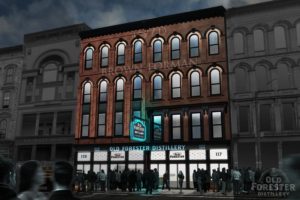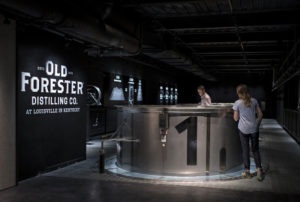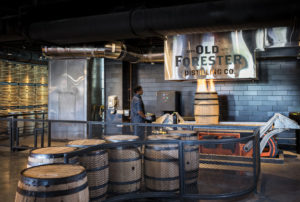Touring Old Forester
By Richard Thomas

Louisville has long contested Bardstown’s claim as “The Bourbon Capital of the World,” but it hasn’t always had much of a case to press in that department. There was a stretch of a few years back in the 1990s where just one big distiller was operating in the Louisville suburb of Shively, and neither of those distilleries were open to the public. Going back to five years ago, and the only urban bourbon-making experience a visitor could get in the Derby City was the Evan Williams Experience.
Louisville has seen a sea change in its tourist experience since then, developing seven tourist destination whiskey distilleries in the downtown area, plus one more, Copper & Kings, making brandy. Leaving aside questions of brand loyalty, each has their own particular strong points, but the urban bourbon distillery that presents the most complete picture of how bourbon is made is Old Forester, hands down.

(Credit: Brown-Forman)
Paying A Visit To George Garvin Brown’s Digs… Almost
When George Garvin Brown started Old Forester, and what would later become the drinks goliath Brown-Forman Corporation, he started out on 322 W. Main Street on Louisville’s Whiskey Row. So, it’s not exactly accurate to call the location of the Old Forester Distilling Co. on 119 W. Main Street his old office, but it’s close enough as these things go.
The first time I saw the project, located in the heart of downtown Louisville, it was November 2016 and the site was just a hole in the ground fronted by an antique brick facade. The distillery opened last summer, followed by the opening of its in-house bar George in October, but I was only able to come around again in February 2019.
The three year wait was worth it. Old Forester presents a sleekly modern look at how bourbon is made while retaining some of the 19th Century charm of the original building, and all the while keeping a grip on the practical, often industrial aspect of making whiskey. Masonry that is a century and a half old and reclaimed (but only decorative, not structural) ceiling joists join displays of brand antiques, but in an experience that is first and foremost a recently constructed, thoroughly modern factory.
In terms of how that factory operates, Old Forester sits in a middle space on the urban bourbon trail: on one side are the outfits operating on a craft whiskey level, and on the other are medium-sized entities (like Angel’s Envy and Rabbit Hole). I was surprised by how large Old Forester’s column still and doubler were, sitting very much as the vertical backbone of the building. It’s capable of producing 100,000 proof gallons per year, well above the usual ceiling for defining a craft distillery, although less than half as much as a medium-sized producer.

(Credit: Brown-Forman)
For the visitor interested in learning about bourbon, Old Forester presents a trade off. They ship their cooked mash in from the Shively plant, so the very beginning of the process is absent. Against that, the facility has its own mini-cooperage. All of the barrels made there are used on site, and, in another distinction, some of them will be aged there as well. Old Forester Distilling Co. has its own warehouse, a towering, climate controlled, multi-story cavity in the building capable of holding 900 barrels.
This emphasis on barrel making and aging is why I believe Old Forester presents the most complete picture of making bourbon whiskey. That barrel and time in the warehouse contribute all of the color and, depending on what distiller you talk to, between 40 and 80% of the flavor of the whiskey. Old Forester is the only place where you can see barrels being made as an integral part of the tour and process, as well as seeing some of them laid up for aging on the premises (not merely empties there for decoration).
This emphasis on the barrel side of making bourbon suits Brown-Forman, the only whiskey-maker that has vertically integrated its production by owning its own cooperages. Of course, a special edition of Old Forester, made and aged at the downtown site. The company anticipates a release by 2024, but that is just a projection and it’s hard to say just how the whiskey will mature at the new site and when it will be ready.



